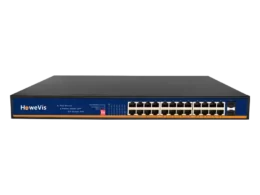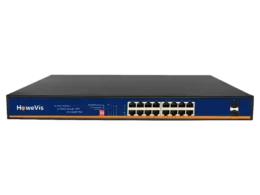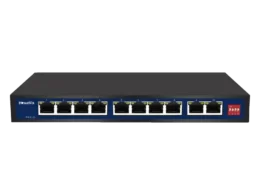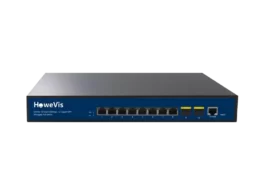Welcome to the Power over Ethernet (PoE) era for lighting, where the simplicity of modern technology meets innovation in system architectures and design. PoE technology transforms how we power our lights, offering a streamlined alternative to traditional electrical wiring. This advanced approach powers LED lighting fixtures and incorporates smart energy management and ease of installation. Experience the shift as PoE redefines the landscape of lighting solutions, making integrating smart lighting systems practical and efficient. Step into a brighter future as PoE turns on a new era in lighting technology.
Power over Ethernet (PoE) for lighting is an innovative technology that has transformed how lighting systems are installed and managed. By allowing power and data to be transmitted over a single Ethernet cable, PoE simplifies the installation process, reduces material costs, and enhances the flexibility of lighting systems. Here’s an overview of the top benefits and some smart integration tips for utilizing PoE in lighting solutions:
Top Benefits of PoE for Lighting
- Simplified Infrastructure: PoE eliminates the need for separate electrical wiring, reducing the complexity of installation and making it easier to manage and maintain the lighting system.
- Cost Savings: With reduced material requirements and less labor-intensive installations, PoE can lead to significant cost savings in both the short and long term.
- Energy Efficiency: PoE-enabled LED lights are inherently energy-efficient, and integrating intelligent lighting controls can further optimize energy usage, leading to lower utility bills.
- Scalability: Adding or changing lights in a PoE system is straightforward, allowing for easy scalability as space evolves.
- Intelligent Control: When integrated with innovative building systems, PoE lighting can be monitored and controlled remotely, offering advanced features such as occupancy sensing, daylight harvesting, and scheduled dimming.
- Safety: Low-voltage PoE systems reduce the risk of electrical hazards, making them safer for installers and users.
- Data Collection: Smart PoE lighting systems can collect valuable data on usage patterns and environmental conditions, providing insights that can be used to optimize building performance further.
Smart Integration Tips
- Plan Ahead: Before installation, carefully plan the layout of your PoE lighting system to ensure optimal coverage and control.
- Quality Hardware: Invest in high-quality PoE switches and fixtures to ensure the reliability and longevity of your lighting system.
- Centralized Management: Use a centralized management platform.
Advantages of PoE Lighting Systems
Cost Savings
Power over Ethernet (PoE) lighting systems offer significant cost savings during installation. Traditional electrical wiring requires separate cables for power and data, leading to higher material costs and labor charges. A single network cable carries both with PoE, slashing the need for extensive wiring.
The reduced cabling also means fewer man-hours spent on installation. This simplifies the process as electricians don’t have to run multiple wires through walls or ceilings for light. The streamlined approach translates into lower upfront investment.
Simplified Maintenance
Maintenance becomes much easier with a centralized power source. A PoE system allows technicians to pinpoint lighting issues quickly from one location rather than checking individual light fixtures. This central control can lead to faster repairs and less downtime.
Moreover, maintenance personnel often find it familiar territory since the system uses standard network equipment like switches and routers. They can apply their IT skills directly without needing specialized electrical training.
Energy Efficiency
PoE lighting systems are known for energy efficiency, leading to lower operational costs over time. These systems use LED lights that consume less energy than traditional bulbs while providing the same brightness level.
Because these light LEDs are connected through an intelligent network, they can be managed more effectively—dimmed when necessary or turned off when not in use—further reducing energy consumption.
Outdoor Security Lights and PoE Compatibility
Remote Management
PoE technology simplifies the management of outdoor lighting. It allows for adjustments from a distance. This means you can control lights without being physically present. Network administrators can switch lights on or off, change brightness, and schedule operations.
The convenience is apparent during unexpected weather changes or special events. For instance, if a storm is approaching, you might want to increase illumination for safety reasons. Or if an area needs to be closed off for maintenance, lighting can be turned off remotely to signal this.
Integrated Security
Security systems benefit significantly from PoE compatibility. Cameras and motion sensors often pair with these lights. When movement is detected at night, the system triggers the lights automatically. This deters intruders effectively.
Imagine a scenario where an unauthorized person steps onto your property at night—their presence would activate bright lighting immediately. This could scare them away before they cause harm or steal anything.
Weather Resistance
Outdoor fixtures must endure elements like rain, snow, and heat. PoE-compatible security lights are designed with weather resistance in mind—this ensures longevity even in harsh conditions.
Consider coastal areas where saltwater corrosion is common; using durable PoE fixtures here would prevent frequent replacements due to damage from salty air exposure.
LED Recessed Lighting in PoE Applications
Network Control
Power over Ethernet (PoE) technology transforms lighting systems. It allows LED recessed lights to be controlled through network commands. This leads to seamless dimming and color changes that can adapt to different needs or moods.
Users can adjust brightness levels with a simple click. They can also change colors for various occasions without manual adjustments. For instance, lights may be dimmed during a presentation for better screen visibility. Or they might shift to a warmer hue at sunset, creating a cozy atmosphere.
Lifespan Benefits
The pairing of LEDs with PoE offers another significant advantage: an extended lifespan for the lighting fixtures. LEDs live longer than traditional bulbs, but PoE adds even more longevity.
PoE delivers efficient power management and reduces electrical stress on the lights. As a result, you won’t need replacements often. Think of it like jogging instead of sprinting; your energy lasts longer when appropriately conserved.
Integration Ease
One great benefit of using LED recessed lighting with PoE is its easy integration into existing networks. Most buildings today are wired for internet connectivity, which makes adding PoE straightforward.
It’s not about redoing infrastructure but tapping into what’s already there—a cost-effective solution that minimizes disruption during the installation process.
Businesses find this particularly appealing as they seek innovative building technologies without significant renovations or downtime.
Smart Buildings and PoE Integration
Energy Monitoring
Smart buildings use Power over Ethernet (PoE) to enhance efficiency. This tech allows for real-time energy monitoring. It tracks how much power lighting systems use. Building managers can see this data and make changes to save energy.
Real-time monitoring means problems get fixed faster. For example, if a light uses too much power, it’s immediately noticeable. Then, steps can be taken to correct the issue quickly.
Automated Adjustments
PoE also supports automated lighting adjustments. These are based on occupancy sensors within a building. When rooms are empty, lights dim or turn off automatically.
This automation helps cut down on wasted electricity from unused spaces. Imagine a conference room that adjusts its lights when no one is there!
System Interoperability
Interoperability is key in smart building design. PoE lighting systems work with other intelligent technologies in the building.
For instance, heating and cooling can sync with lighting for total environment control. The system might lower heat settings and dimming lights if fewer people are in an area.
Understanding IEEE 802.3 Standards for PoE
PoE Variants
Power over Ethernet (PoE) technology has evolved. Different standards exist to meet various needs. Let’s explore the differences.
The original PoE standard, IEEE 802.3af, supports up to 15.4 watts per port. It powers devices like IP cameras and VoIP phones effectively. Next is PoE+ (IEEE 802.3at), which provides up to 30 watts per port and is suitable for more demanding devices such as dual-band wireless access points.
For high-power needs, there’s UPoE (Universal Power over Ethernet) or IEEE 802.bt with a massive jump in power, delivering up to 60-100 watts per port. This can run laptops and TVs through an Ethernet cable!
Power Limits
Knowing the power limits of each standard is crucial for planning.
With IEEE 802.af, you’re limited, but it works well for smaller devices that don’t draw much power. IEEE 802.at gives you more room with double the wattage of its predecessor. And then there’s UPoE; it’s like having a powerhouse at your fingertips! But remember, not every device needs this much juice.
Scaling your network means carefully considering these limits so everything runs smoothly without tripping circuits.
Compatibility Check
Compatibility is critical when integrating PoE into intelligent buildings. Make sure all parts speak the same language – metaphorically speaking!
Some older infrastructure might only support basic PoE standards, while newer ones are geared towards UPoE capabilities. So when choosing devices or upgrading systems, always check if they match your current setup or if changes are needed.
It’s like fitting puzzle pieces together; they must fit perfectly to complete the picture without forcing them into place.
Key Features of PoE Lighting Systems
Backup Power
PoE lighting systems offer centralized backup power solutions. This is crucial for emergencies. When the main power fails, lights can stay on. This keeps people safe.
Centralized backups are more efficient than individual battery units. They are easier to maintain; this means quick checks and less downtime in a large building.
Network Control
These systems use networks for control. Users can set schedules and scenes with ease. It’s all done through a software interface or app.
Imagine changing lighting settings across an entire campus from one spot! That’s the convenience offered here.
Usage Analytics
Advanced analytics turn data into insights about how we use lights. These systems track usage patterns over time.
Facility managers get reports on which areas use more light and when. They can then adjust to save energy and money.
The Role of PoE in Smart Building Automation
IoT Connectivity
Power over Ethernet (PoE) is transforming how we light our buildings. It makes IoT connectivity simpler. With PoE, lights do more than illuminate. They connect to the internet. This allows for smart control and data sharing.
In a building, each light can become a data point. Imagine a network of lights collecting information on room occupancy or temperature changes. This info helps manage energy use better.
Innovations in PoE Lighting for Modern Workspaces
Human-Centric Design
Power over Ethernet (PoE) technology has revolutionized workspace lighting. It supports human-centric designs. These systems focus on people’s well-being. They change light based on time and needs.
Human-centric PoE lighting can improve mood and energy levels. For example, cooler, brighter lights boost concentration during work hours. Warmer tones help relax as the day ends.
Adaptive Systems
Adaptive lighting is a game-changer for modern offices. It uses sensors to detect natural light levels in a room. The system then adjusts artificial lighting accordingly.
This means when it’s sunny outside, lights dim to save energy and reduce glare. On cloudy days or evenings, they brighten up spaces automatically.
Customizable Lightscapes
Customization is key in PoE-enabled lighting applications.
- Users set different colors and intensities.
- Lights create scenes that support various activities.
For instance, one might choose vibrant colors for brainstorming sessions but softer shades for focused tasks.
Selecting the Right PoE Lighting Product
Wattage Assessment
When choosing PoE lighting solutions, assessing your wattage needs is crucial. Start by calculating the power requirements of each light fixture. Then, compare this with your network’s PoE power budget. This ensures that your system can handle the load without overloading circuits.
Most PoE switches provide up to 30 watts per port. But some devices need more power. For instance, high-lumen fixtures may exceed standard limits. In such cases, look for extended-power options or plan for additional switches.
Network Compatibility
Your current network setup affects your choice of PoE lighting products. Check if new lights will work with existing components like routers and switches.
Some older equipment might not support newer PoE standards. Upgrading may be necessary to ensure compatibility and optimal performance. For example, a switch from 2008 might not pair well with modern LED panels designed for advanced networks.
Support Services
Manufacturer support is key when selecting PoE lighting systems. Look for companies offering strong warranty policies and technical assistance. This gives you peace of mind, knowing help is available if issues arise.
A good warranty often covers replacements or repairs within a certain period. Consider brands known for responsive customer service as well. They can guide you through installation hiccups or troubleshooting steps effectively.
Summary
Power over Ethernet (PoE) is revolutionizing how we light up spaces, from sleek, intelligent buildings to robust outdoor security setups. By merging power and data delivery over a single cable, PoE simplifies installation and opens up a world of innovation in lighting technology. You’ve seen how LED recessed lights can now be more intelligent, how modern workspaces benefit from adaptable illumination, and how standards like IEEE 802.3 ensure your system is robust and safe.
As you stand at the cusp of choosing a PoE lighting product, remember that each choice paves the way for a brighter, more efficient future. Dive in—select a system that not only meets your needs today but also aligns with the smart automation of tomorrow. Let’s illuminate the path forward together; reach out for guidance, or take the plunge with PoE lighting that transforms your space into a beacon of innovation.
Frequently Asked Questions
What are the advantages of PoE lighting systems?
PoE lighting systems offer energy efficiency, simplified installation, and centralized power management. They reduce cabling needs and can be easily integrated into smart building networks.
Can outdoor security lights use PoE technology?
Many outdoor security lights are compatible with PoE, allowing easier installation and better integration with surveillance systems.
Are LED recessed lights suitable for PoE applications?
Absolutely! LED recessed lights work well with PoE applications due to their low power requirements and long lifespan.
How does PoE contribute to smart building automation?
PoE plays a pivotal role in smart building automation by powering devices through Ethernet cables, facilitating easy control over lighting systems as part of an interconnected network.
What should I know about IEEE 802.3 standards for PoE, including system architectures, benefits, and edge applications?
The IEEE 802.3 standards define the operation of Power over Ethernet (PoE), ensuring the safe delivery of power along with data over standard Ethernet cables.
What key features do PoE lighting systems have?
Key features include remote control capabilities, energy monitoring, lower installation costs than traditional wiring methods, and seamless integration into existing IT infrastructure.
How do I select the right PoE lighting product?
When selecting a PoE lighting product, consider your space’s size, desired brightness levels, existing infrastructure compatibility, and specific features like dimming or color-changing abilities.











